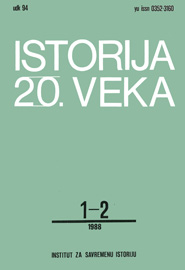MILITARIZACIJA FIZIČKE KULTURE U KRALJEVINI JUGOSLAVIJI 1929 - 1935
THE MILITARIZATION OF BODILY CULTURE IN THE KINGDOM OF YUGOSLAVIA 1929 - 1935
Author(s): Nikola ŽutićSubject(s): Military history, Interwar Period (1920 - 1939), Sports Studies
Published by: Institut za savremenu istoriju, Beograd
Keywords: Kingdom of Yugoslavia; bodily culture; sport; militarization; interwar period; "Soko";
Summary/Abstract: The state intervention in the field of bodily culture (1929 - 1934) was brought upon in order to use this field for the propaganda of Yugoslav nationalism, but also because of the military training of citizens in the organizations of bodily culture. The limitations of the Versailles conference and the Disarmament conference in 1932, concerning the number of soldiers and the diminished of armaments, imposed a need for organizing half-military formations in most of the European countries. The ,,Soko” (Falcon) of the Kingdom of Yugoslavia, a liberal Yugoslav institution, was the main training ground of youth military exercise before the regular service. The „Soko" work in the field of bodily education, consisted of bodily exercise and sport, and sports including elements of military training exercise were especially worked upon (marching exercises, marksmanship, skiing, horsemanship). Sport in the Kingdom of Yugoslavia, organizationally linked with the state Federation of sport organizations, due to its popularity among young people, gained an important role in the youth military education. The Yugoslav fire-department, state owned in 1933, exercised passive defense preparations, i. e. the system of the protection of the country from air-raids. In the year of 1934, the organization of Obligatory bodily exercise was founded, and it was supposed to include in its military system of exercise all categories of young people, especially those from the villages, whom the state did not manage more numerously to include, by its previous intervention, in the „Soko” organization.
Journal: Istorija 20. veka
- Issue Year: 1988
- Issue No: 1+2
- Page Range: 109-124
- Page Count: 16
- Language: Serbian

